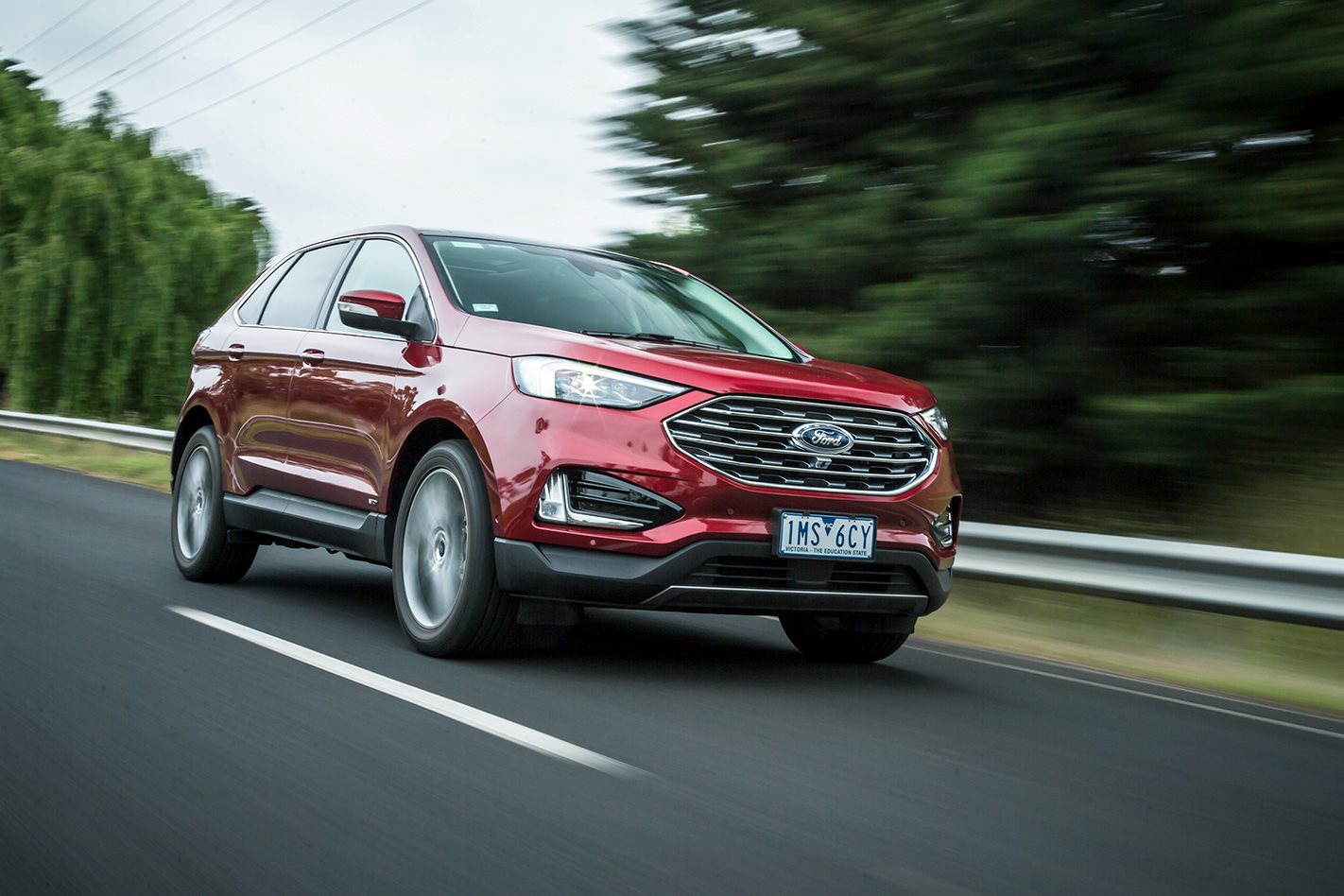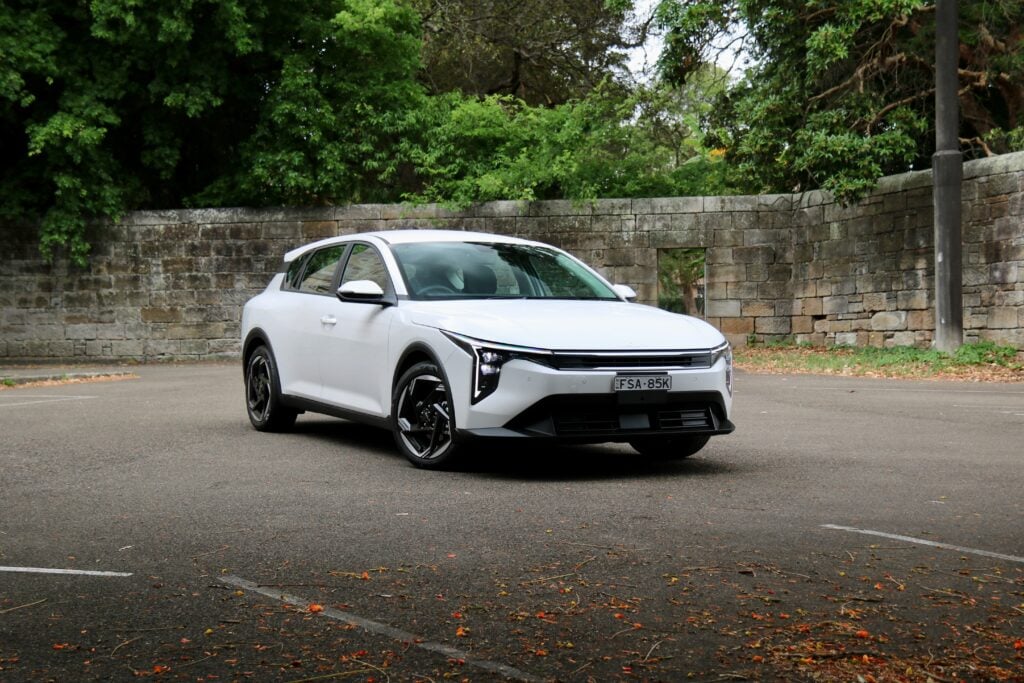
Score breakdown
Things we like
- Punchy engine
- Roadholding, cabin space, standard features
Not so much
- Dated dashboard, no petrol option
What stands out?
The Ford Endura is Ford Australia’s first large soft-road SUV since it stopped producing the Territory. It is powered by a 2.0-litre turbo-diesel that’s both powerful and relatively economical. It is good to steer, with polished cornering manners for a large SUV. There are front-drive and all-wheel-drive versions, and auto-braking is standard.While it first arrived in Australia at the end of 2018, the Ford Endura is a facelifted version of the second-generation Ford Edge, which has been on sale internationally since 2015.
What might bug me?
Reminders that your brand-new Endura is actually a facelifted version of the 2015 Ford Edge, such as the dated dashboard designBeing passed by BMW X3 and Volvo XC60 versions that are cheaper than your Endura Titanium.When you lurch forward a little after turning off the engine and taking your foot off the brake. The electronic handbrake doesn’t automatically engage when you select park.
What body styles are there?
Five-door wagon only. The Endura seats five people and is classed as a large SUV, lower priced.Each Endura variant comes with a choice of front- or all-wheel-drive.
What features do all Endura versions have?
Adaptive cruise control, a reversing camera, and parking sensors front and rear.A sound system with a CD player, AM/FM and digital radio, USB input, and at least six speakers. Bluetooth connectivity, which allows you to wirelessly connect a phone and play music from it.Satellite navigation, displayed on an 8.0-inch colour touchscreen with Ford’s excellent SYNC3 connectivity. SYNC3 allows voice control of the sat-nav, the digital radio, and other audio and phone functions.Support for Apple CarPlay and Android Auto, which lets you display apps from compatible smartphones on the touchscreen and control them from there.Active noise cancellation that uses a signal to electronically reduce cabin noise, much like noise-cancelling headphones.Push button start, and smart keyless entry that unlocks the Endura without the need to take the key fob out of your bag or pocket.10-way power adjustable driver’s seat.Power-folding and heated door mirrors that light up the ground near the front door as you approach and unlock your Endura.Rain-sensing windscreen wipers, LED cornering headlights with auto on-off high beam, LED fog-lamps and daytime running lights.A leather-wrapped steering wheel, with paddle gear shifters, and buttons for operating cruise control, sound system and your phone.Dual-zone air-conditioning (which allows different temperatures on either side of the cabin), and air-conditioning vents dedicated to rear-seat passengers.Electronic stability control, which can help control a skid. All new cars must have this feature.Seven airbags. (For the placement of airbags, and more on Endura safety systems, please open the Safety section below.)Autonomous emergency braking, forward collision warning, lane-keeping assist, and traffic sign recognition.The Escape is covered by a five-year, unlimited kilometre warranty.
Which engine uses least fuel, and why wouldn’t I choose it?
Each Ford Endura version is powered by a 2.0-litre, four-cylinder turbo diesel engine, with a choice of front- or all-wheel drive traction.Both FWD and AWD versions offer excellent fuel economy for a large SUV – 6.7 litres/100km on the official combined test. Driving each version in real world conditions saw that figure creep up about 8.5 litres/100km.All Enduras have an eight-speed automatic transmission that selects gears smoothly and provides more than adequate power. It has a sport mode that allows the engine to rev more before changing gears for when you want to get up to speed a little quicker.Power outputs and all other Ford Endura specifications are available from the Cars Covered menu, under the main image on this page.
What key features do I get if I spend more?
The least costly Endura, the Trend FWD, has cloth seats, rolls on 18-inch alloy wheels, and has the equipment in all Enduras.It only drives the wheels at the front, but spending about $4000 extra gets you an Endura Trend AWD that drives to all four wheels when needed, which brings you more security on slippery surfaces. This option is available across the Endura range.Spending a little more brings you the Endura ST-Line brings a sports-tuned suspension, 20-inch alloy wheels, and sporty exterior design enhancements including an ST-Line bodykit.Inside, the Endura ST-Line features ambient lighting, and sports seats with suede trim with leather accents, with the front passenger seat gaining 10-way power adjustments. Both front seats feature heating and cooling, and the driver’s seat has position memory settings. The steering wheel is trimmed with perforated leather, and there are aluminium pedals and scuff plates.The most expensive Endura, the Titanium, has a luxury focus with most of the features found in the ST-Line, but with plush leather-accented seats.It gains a panoramic sunroof, power-operated steering column adjustment, heated second-row seats, and power-operated tailgate with hands-free operation.Safety tech is also boosted with the addition of blind-spot detection and rear-cross traffic alert, and the Endura will almost park itself with active park assist.OptionsYou can add additional features to the Endura Trend for an additional cost including bigger 19-inch wheels, a panoramic sunroof, DVD screens for rear-seat passengers mounted in the front headrests, and a tow bar.Additional options for the ST-Line include the panoramic sunroof, DVD screens and tow-bar, plus a premium 12-speaker audio system with 180-degree split-view parking camera, and active park assist.Titanium options include the 12-speaker sound system, DVD screens, tow-bar, and micro-perforated leather-accented seat trim.
Does any upgrade have a down side?
The larger, lower profile tyres on the ST-Line and Titanium could cost more to replace and reduce ride comfort slightly (because there is less cushioning air between the wheel and the road).Oxford White is the only standard colour, with the other nine costing extra.
How comfortable is the Endura?
The Endura is excellent for long family drives, with a spacious cabin that offers plenty of leg and elbow room. Headroom is ample too, even with the panoramic sunroof installed.It is easy to get comfortable in the driver’s seat, thanks to the 10-setting power-adjustments, and vision is excellent. The front seats provide good back and side support, even in the more affordable Trend, which helps when driving through bends. And there’s enough padding and support for long trips.The rear seats also provide good support and can partially recline. Putting a third adult in the middle does makes things a little tight though. Children will have no such problems.Despite its size, the Endura feels relatively nimble around town, with light but nicely weighted steering. And it’s manageable in tight parking spots.It’s quiet, too, with good soundproofing that’s enhanced by electronic active noise cancelling technology, which eliminates much of the noise associated with diesel engines.The interior fit and finish is a little plain, even in the most-expensive Endura Titanium, but the overall quality is good.The dashboard is similar to older Ford models, including the Aussie-built Territory, though it’s less cluttered and bulky than the Ford Escape’s.The 8.0-inch infotainment screen is located a little low within the dash, but it does use Ford’s latest Sync3 infotainment system with inbuilt sat-nav and Apple CarPlay/Android Auto smartphone pairing. You also get a CD player, which is becoming increasingly quaint these days.
What about safety in an Endura?
The Endura has anti-lock brakes, stability control, and seven airbags. There is a seatbelt warning system for all five passengers, which is reassuring for parents. A reversing camera and front and rear parking sensors are standard.It’s one of the most advanced Ford models sold in Australia in terms of active safety, with all versions featuring autonomous emergency braking that can detect pedestrians as well as other vehicles.Lane-keeping assist, and traffic sign recognition are also standard, with the more expensive Endura Titanium gaining rear-cross traffic alert and blind-spot monitoring.Adaptive cruise control, which can match your speed to that of a slower car ahead on the highway until you are free to overtake, is also included across the range.All Endura versions also get auto LED headlights that illuminate when it gets dark. In addition, your headlamps switch to low beam automatically for oncoming drivers, and a pressure monitor warns you if a tyre is going flat (perhaps giving you more time to get a slow puncture seen to). And the windscreen wipers can also operate automatically when it rains.The seven airbags are in the usual places: one in front of each front seat occupant; one to protect the driver’s knees; side airbags outside each front seat to protect at chest level from side impacts; and curtain airbags that protect the heads of front and rear occupants from side impacts.The outboard rear seats have ISOFIX child seat anchorage points.The Australasian New Car Assessment Program (ANCAP) awarded the Endura five stars for safety.
I like driving – will I enjoy this car?
Yes. The Endura is one of the better affordable large SUVs to drive. It steers fluidly, and feels poised and precise in bends. That builds confidence. This is especially the case with the ST-Line, which has a sports suspension to improve handling without compromising ride comfort.The 2.0-litre turbo diesel engine feels refined and provides enough grunt for suburban and highway driving with plenty of power in reserve for overtaking.There is a sports mode button in the middle of the rotary gear-selector that partially overcomes turbo lag and allows the eight-speed automatic to rev higher before changing gears for quicker acceleration when needed.All Endura versions provide a comfortable driving position and excellent visibility.All-wheel drive versions can operate on moderate dirt tracks and snow-covered roads.
How is life in the rear seats?
The Endura’s rear seats partially recline, and a central armrest (with two cupholders) makes life more comfortable when there are just two rear passengers.All Enduras have rear air-conditioning vents, plus a 12-volt and 230-volt sockets to plug in devices and phone chargers.With the armrest folded, a central rear passenger sits higher than the outer two. Compensating partly for that is the near-flat shape of the rear floor.Leg room is generous, and overall the rear compartment feels invitingly airy. Headroom is excellent too even with the panoramic sunroof.
How is it the Endura for carrying stuff?
The Endura has a generous 800-litre boot space, which is well above average for large SUVs. That said you might have some trouble fitting taller, bulkier loads because of the raked-forward tailgate glass.The boot floor lifts to reveal a space-saver spare tyre and several storage compartments.The Endura has a braked towing capacity of 2000kg.
Where does Ford manufacture the Endura?
The Ford Endura is manufactured in Canada.
What might I miss that similar cars have?
Perhaps the capacity to seat seven passengers, which is a feature of most large SUVs including the Holden Acadia, Hyundai Santa Fe, Kia Sorento, Mazda CX-8 and CX-9, Nissan Pathfinder, Skoda Kodiaq and Toyota Kluger.A nippy petrol version that’s better suited to urban driving, as available with the Acadia, CX-9, Pathfinder and Kluger.Or you might want a large SUV with better off-road capability such as the Ford Everest, Mitsubishi Pajero Sport, Holden Trailblazer, Isuzu MU-X, Toyota Fortuner or Toyota Prado.Other large SUVs you might contemplate include the Jeep Grand Cherokee and Subaru Outback, while spacious medium SUVs such as the Nissan X-Trail and Honda CR-V (which are both available with seven seats) could also be considered rivals.
Are there plans to update this model soon?
The Ford Endura arrived in Australia at the very end of 2018. While brand new to Australia it is an updated version of the second-generation Ford Edge, which first arrived on the scene in North America in 2015. It is a fresh update though, so don’t expect another update until the at least the end of 2020.
I like this car, but I can’t choose which version. Can you help?
The entry-level Endura Trend AWD offers excellent value, and comes with the same powertrains, performance and many of the features found in the more expensive variants. The AWD traction is better for towing.
Score breakdown
Things we like
- Punchy engine
- Roadholding, cabin space, standard features
Not so much
- Dated dashboard, no petrol option




